by Aleks Kajstura,
September 10, 2015
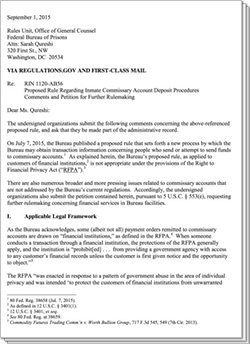 A couple of weeks ago, we wrote about the Bureau of Prisons’ newly proposed rule, which attempts to circumvent financial privacy protections for people who send money to their incarcerated loved ones.
A couple of weeks ago, we wrote about the Bureau of Prisons’ newly proposed rule, which attempts to circumvent financial privacy protections for people who send money to their incarcerated loved ones.
The BOP solicited comments on the proposed rule, and the Prison Policy Initiative, along with Dēmos, Human Rights Defense Center, and the National Consumer Law Center, sent them a 7-page letter explaining why the proposal was a bad idea.
If you’d like to skip over the details, however, our conclusion gives a quick summary of the problem:
Congress enacted the RFPA [Right to Financial Privacy Act] to provide customers of financial institutions with protections against government intrusion into their financial privacy. Although the statute does allow customers to voluntarily disclose their financial information to the government, it is carefully drafted to ensure that such consent is narrowly-tailored and not coerced. The Bureau’s proposed rule runs roughshod over these statutory protections and should not be adopted in its present form.
Moreover, in the rapidly-changing world of prison-based financial services, there are numerous consumer protection problems that are in acute need of attention. It is, therefore, disappointing that the Bureau has chosen to focus its efforts on eroding privacy protections instead of proposing regulatory changes that would benefit incarcerated people and their families by curbing financially abusive practices.
The comment period ended two days ago, but there’s no word yet on when a final decision will be made.
Meet PPI board member and associate professor of political science, Khalilah L. Brown-Dean
by Bernadette Rabuy,
September 9, 2015
We are very excited to introduce a member of the Prison Policy Initiative board: Khalilah L. Brown-Dean. Khalilah L. Brown-Dean is an Associate Professor of Political Science at Quinnipiac University. Check out the interview below to learn why Khalilah was drawn to the PPI board:

Why did you decide to join the PPI board?
Khalilah L. Brown-Dean: Academics tend to work in silos. We focus in on a particular problem or set of problems and are rarely in conversation with those beyond our discipline. Joining the PPI Board provides a meaningful opportunity to learn from and work with others who are committed to dismantling our reliance on punishment. I envision my role as helping to bridge the gap between scholars, activists, philanthropists, and legislators.
What does your work focus on? And what’s the connection between that work and the Prison Policy Initiative?
KBD: My work is driven by a central question: How can we make the democratic experience more meaningful? I address this question through the lens of American Politics with a particular emphasis on mass political behavior, public policy, and law. I recently co-authored a report for the Joint Center for Political and Economic Studies on the contemporary status of voting rights in the United States entitled “Fifty Years of the Voting Rights Act: The State of Race in Politics.” I had the opportunity to present the key findings during the 50th Anniversary of the Bloody Sunday March in Selma, Alabama. Our research addressed how issues such as disenfranchisement, gerrymandering, and hyperincarceration pose monumental challenges to sustaining voting rights and representation. It’s a perfect fit with the work of PPI.
I’m currently completing a project that centers the experiences of African Americans and murder victims’ families within the death penalty repeal movement; two groups disproportionately affected yet grossly underrepresented within this policy space. I advance a concept called “authentic power” to explain how those detrimentally impacted by a policy can get policymakers and other government officials to change the policy in question to their benefit. The work grows out of my experience advocating on behalf of victims’ families whose needs often go overlooked in the realm of criminal justice reform. I also serve on the Board of the Community Foundation for Greater New Haven. This year we launched two major funding initiatives to support community-based re-entry and immigration.
What do you think is most unique about the Prison Policy Initiative and the projects it takes on?
KBD: My Graduate School mentor, Dr. William E. Nelson, Jr., once told me that research is only meaningful if it helps address a deceptively simple question, “So what?” PPI’s work directly addresses that question by using data to tell a complex story about the myriad ways punishment policies widen the gap between the principle and the practice of American democracy. I greatly admire PPI’s ability to make its work timely, relevant, and accessible to multiple audiences.
What’s something that you wish more people knew about the Prison Policy Initiative?
KBD: I wish people knew that PPI is a small organization with a big mission and an even bigger commitment to advancing the cause of justice. Before I joined the Board I assumed PPI had a massive staff with unlimited resources given the many cutting-edge and widely-cited reports it produces. I was wrong!
Blaming the 1990s public for mass incarceration is too simple of an answer.
by Peter Wagner,
September 3, 2015
For an essay about the Democratic presidential candidates reversing their previous support for tough on crime measures, German Lopez pulls up some fascinating data, although I’m not quite sure he puts the emphasis in the right spot.
First, Lopez is absolutely right that private prisons aren’t why we have mass incarceration. And he’s correct on his main point that “liberals like Hillary Clinton, Joe Biden, and Bernie Sanders supported the 1994 crime law that contributed to mass incarceration” simply because, well, they were politicians in the 1990s. At that time, “all politicians — liberal and conservative — t[ook] a tough stance on crime.”
And he’s spot-on about how political power works and why the people powerful enough to run for president in the present typically had to be on the winning side in the past:
Popular demand for tough-on-crime laws in the past doesn’t in any way excuse the devastation lawmakers inflicted on millions of people through mass incarceration and other policies. But based on voters’ concerns in the 1990s, if a politician didn’t contribute to the problem back then, he or she may not be prominent enough to run for president today. That’s how America ended up with mass incarceration — and the seemingly contradictory Democratic presidential candidates for 2016.
However, the article offers an overly simple answer to “the simple truth about why mass incarceration happened.” By concluding that “the public wanted mass incarceration”, Lopez stops one step too short.
Lopez relies on this chart showing the portion of the country that considered crime “the most important problem”:
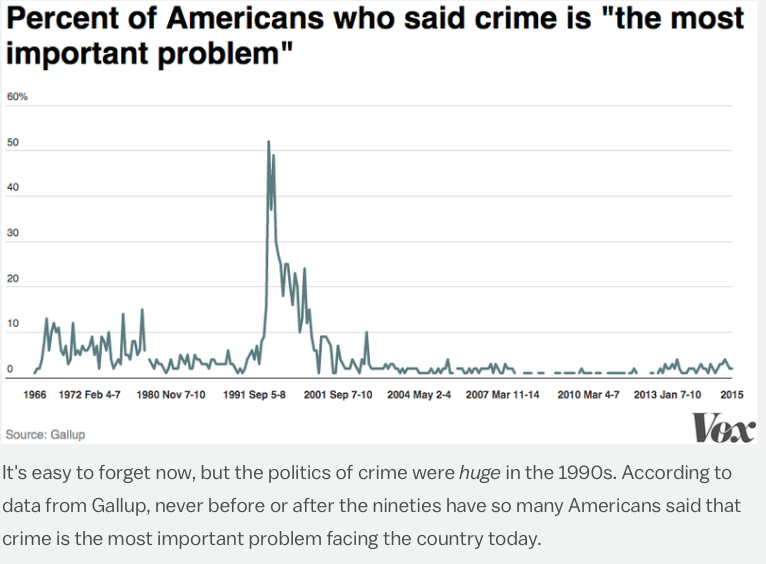
What could possibly be responsible for the number of people identifying crime as “the most important problem” jumping from almost nothing in 1991 to more than half the population in 1993? (And a related question that I’ll address later is: Did the public really want Congress to double down on cops, courts, and cages?)
To be sure, crime was higher than it is now and was rising in the 1980s and early 1990s, but the crime rise on its own was far too subtle to cause that spike in public concern. As the opening to the video that Lopez embeds so brilliantly demonstrates, the media (and ideologues manipulating the media) created that crime focus.
Joel Dyer has a whole chapter in his now-dated book about the rise of what he calls the Perpetual Prisoner Machine focusing on how the television news of that era manipulated public fear of crime because it got good ratings and because crime reporting was inexpensive to produce.
As David Mendoza brilliantly showed last year, Americans are consistently bad at knowing whether the national crime rate is going up or down. Most years, most Americans think crime is rising even though it’s been in decline for years. Of course, it’s hard for a single American to know from personal experience whether crime is rising or falling, so the media has a big influence there. Similar public opinion polling that asks whether crime is rising or falling in your neighborhood shows a much smaller disconnect with actual crime rates, offering clear evidence that Americans aren’t stupid but they are (or were) being lied to.
Now despite that, I think there are reasons in a different set of Gallup data to be optimistic: In contrast to the actions of elected officials, Americans have long favored attacking social and economic problems as a crime control strategy over spending more on law enforcement. Even at the low point in 1994, a clear majority of Americans (51%) supported attacking social and economic problems and only 42% favored using more police and prisons to deter crime:
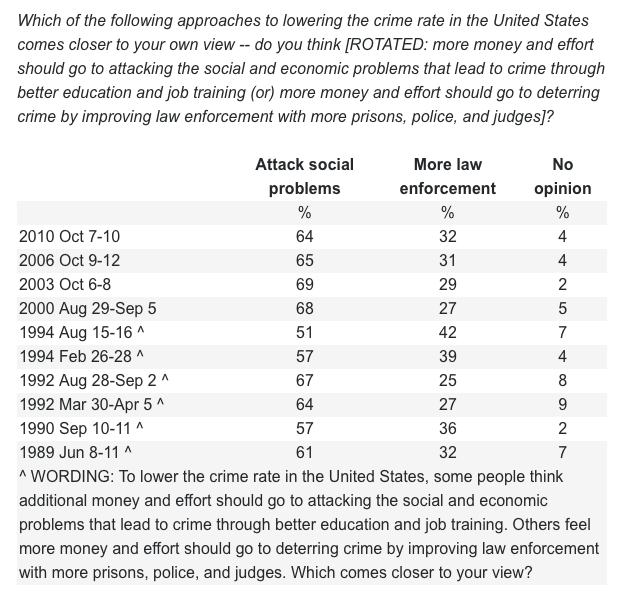
So that gets back to the original question about the presidential candidates who created this problem with their rush to pander to the television cameras: What do the candidates think is the best way to undo the harm their policies caused?
Massachusetts top court says a city can't bar people on the sex offender registry from living in the city.
by Peter Wagner,
September 2, 2015
On Friday, Massachusetts’ highest court unanimously struck down a city ordinance that made virtually the entire city off-limits to people on the state’s sex offender registry.
As the ACLU summarized:
In 2012, the ACLU of Massachusetts and the Committee for Public Counsel Services sued to challenge the restrictions, in a case now known as Doe v. City of Lynn. The Court found these restrictions unlawful, unsafe and ineffective. Their ruling will have the effect of invalidating about 40 similar ordinances in communities across the state.
“The Supreme Judicial Court has unanimously recognized that local ordinances seeking to banish sex offenders are incompatible with state law and, in all likelihood, make the public less safe,” says Jessie Rossman, a staff attorney with the ACLU of Massachusetts. “The Court also wrote that ‘the days are long since past’–citing the internment of Americans of Japanese descent and the forced migration of Native Americans–when entire groups of people ‘may be lawfully banished from our midst.'”
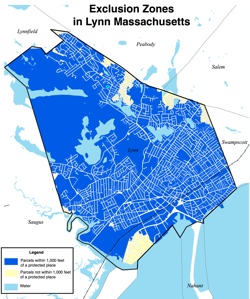 In its ruling, the court cited my maps and expert report showing that the city’s ordinance rendered at least 95% of the residential properties in the city off limits to people on the registry. My map of the city’s exclusion zones demonstrated that by making all areas within 1,000 feet or schools, parks and day care centers off-limits to people on the registry, the ordinance made virtually the entire city off-limits.
In its ruling, the court cited my maps and expert report showing that the city’s ordinance rendered at least 95% of the residential properties in the city off limits to people on the registry. My map of the city’s exclusion zones demonstrated that by making all areas within 1,000 feet or schools, parks and day care centers off-limits to people on the registry, the ordinance made virtually the entire city off-limits.
Like the 2013 decision of a Federal Judge in a Colorado case that I testified in, the Massachusetts court found that the city’s ordinance undermined effective state regulation. As the ACLU explained:
The Court recognized, too, that when lawmakers created the state sex offender registry, the Legislature chose a path meant to protect the public. Ordinances like Lynn’s stand in the way of that intent. “Local residency restrictions undermine the state system by forcing sex offenders into homelessness, which makes them harder to find and destabilizes rehabilitation,” Rossman says.
Ordinances like this also fail to create safe communities. “Our image of the sex offender lurking on the edges of our school playground and parks is simply not true,” explains Dr. Laura Guidry, president of the Massachusetts Association for the Treatment of Sexual Abusers. Dr. Guidry cites figures from the Justice Department, which show that 93 percent of children who are sexually abused are harmed by family members, close friends or acquaintances. This means that residence restrictions will do nothing to stop the most common situations in which children are sexually abused. “What does work are restrictions based upon a careful risk assessment that looks at the risks posed by each individual adult or adolescent in question,” Guidry says.
The Massachusetts ruling comes as part of a growing national trend, in which high courts and officials in states such as New York (link no longer available) and California have rejected similar restrictions.
Links and other resources for attendees at the Iowa Justice Summit where I gave the keynote address on Friday.
by Peter Wagner,
August 31, 2015
On Friday, I gave the keynote address at the Iowa-Nebraska NAACP‘s third annual Iowa Summit on Justice & Disparities, which brought together leaders such as Governor Terry Branstad, state decision makers, law enforcement, and reform advocates to discuss some of the most pressing issues facing the criminal justice system in Iowa.
As a guide for attendees who want more information, I wanted to share some links to the published research I discussed and summaries of some of the unpublished work that I mentioned in my talk.
I addressed the globally unprecedented incarceration boom in the U.S. and Iowa:
I also addressed how even our economic, legal and cultural systems are built upon the assumption of mass incarceration to the detriment of people on both sides of prison walls:
During the Q&A, there were questions about:
And after my talk, I have had several conversations with participants about what the Prison Policy Initiative knows about the burgeoning video visitation industry that often bans in-person jail visits in favor of expensive computer chats nationwide and in Iowa. While more research in Iowa is needed, we know that these Iowa counties have adopted video visitation in some form:
- Buena Vista County
- Cerro Gordo County
- Des Moines County, which contracts with Lattice and charges $20 for a 40-minute visit
- Hardin County, which contracts with HomeWAV
- Iowa County
- Johnson County
- Polk County, which contracts with iWebVisit.com
- Pottawattamie County, which contracts with Securus
- Scott County
- Wapello County, which has replaced family in-person visits with video visits
- Woodbury County, which contracts with Securus
One exciting and immediate development from the Summit is that Governor Branstad has added telephone charges to his Working Group on Justice Policy Reform’s priorities.
If you are interested in bringing the Prison Policy Initiative to you, see our speakers page.
David Segal in the New York Times investigates whether companies that sell things to prisons feel threatened by the talk of prison reform.
by Peter Wagner,
August 31, 2015
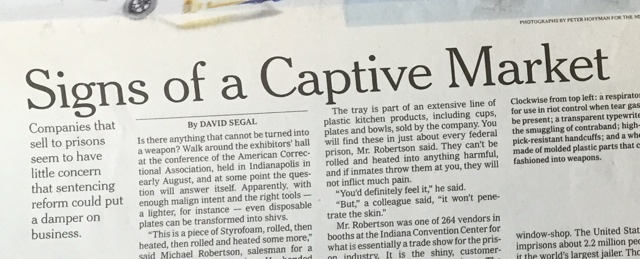 A huge spread in the Business section of the Sunday New York Times focuses on reporter and columnist David Segal’s recent trip to the American Correctional Association conference, where he met companies of all sorts who sell prisons and jails the raw materials — except for people — needed for a prison or a jail. Segal, who also writes as The Haggler covering consumer protection issues and who previously blew the lid off the mugshot blackmail industry here grapples with the questions of policy change and what the companies who profit from the $80 billion spent on corrections each year are doing in response to all of the talk of prison reform:
A huge spread in the Business section of the Sunday New York Times focuses on reporter and columnist David Segal’s recent trip to the American Correctional Association conference, where he met companies of all sorts who sell prisons and jails the raw materials — except for people — needed for a prison or a jail. Segal, who also writes as The Haggler covering consumer protection issues and who previously blew the lid off the mugshot blackmail industry here grapples with the questions of policy change and what the companies who profit from the $80 billion spent on corrections each year are doing in response to all of the talk of prison reform:
For prison vendors, this would appear to be a historically awful moment. Sentencing reform has been gaining momentum as a growing number of diverse voices conclude that the tough-on-crime ethos that was born 40 years ago, and that led to a 700 percent increase in the prison population since 1970, went too far. Mandatory minimum laws, many of them passed at the state and federal level in the ’70s, ’80s and ’90s locked people away for decades, often for relatively minor, nonviolent offenses. Those laws have had a disproportionate impact on African-Americans, who tend to serve longer sentences than whites.
But I’m quoted in a section that goes further to draw a line between all the reform that’s being talked about and what reform has actually looked like:
[The] vendors in Indianapolis seem unruffled by talk of prison reform. It hasn’t had a big impact, at least not yet, and it doesn’t seem that it will in the future.
To understand the “not yet” part, consider California, site of the country’s most ambitious inmate reductions. The court-ordered program to ease cramped, triple-bunk conditions started in October 2011. To date, the system’s head count in the 34 facilities covered by the overcrowding litigation has dropped to 111,000, from 144,000.
But the numbers aren’t quite what they seem. The law passed in 2011 mandated that new offenders sentenced for nonviolent or nonsex crimes would serve their time in county jails. The days when a jail was a just a pretrial holding pen are over, and the population in those cells is starting to bulge. Yes, there has been a net decline in the total population of incarcerated people in the state. Just not at a rate that would alarm anyone selling, say, inmate blankets.
“These declines are too small,” said Peter Wagner of the Prison Policy Initiative, which campaigns for prison reform. “The numbers are trending downward, but slowly and not consistently.”
Mr. Wagner also doubted that prison reform laws knocking around Congress, as well as many states, would reduce the prison population as much as some people thought, because they are focused on drug and nonviolent offenders. As numbers collected by the Urban Institute demonstrate, half of all inmates in state prisons are violent offenders, and state prisons are home to 86 percent of the nation’s inmates.
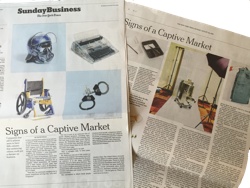 Segal addresses another reason why some of these companies aren’t bothered by talk of prison reform: there are plenty of ways to profit if governments merely transfer their prison addictions to other unnecessary forms of social control. Segal reports:
Segal addresses another reason why some of these companies aren’t bothered by talk of prison reform: there are plenty of ways to profit if governments merely transfer their prison addictions to other unnecessary forms of social control. Segal reports:
[M]any companies are trying to diversify. In 2013, Corrections Corporation of America, the country’s largest private prison company, purchased Correctional Alternatives, which specializes in re-entry programs, like work furloughs and home confinement.
“We have continued to look for opportunities in this service area,” a spokesman for C.C.A. wrote in an email. “It aligns with the needs of our government partners, who are increasingly looking to this type of solution.”
Many at this conference were what could be called platform agnostic, including Norix, which describes itself as the country’s largest maker of prison furniture. Its slogan is “Engineered to endure,” and to illustrate the point, the company ran a looping video at its booth featuring inventive assaults on its furniture. One snippet featured a vinyl armchair being slowly squashed down to 10 inches high by a pneumatic crusher.
When the machine slowly uncrushed the chair, it retook its original shape.
“Sales to prisons are flat to down,” said Sandy Heitman, a senior project manager. “But more people are being put into mental health facilities, and that portion of the business has increased.” The same is true, she added, of halfway houses.
We sat on some Norix furniture, which was the opposite of the austere, steel slabs you see in prison documentaries. Norix still makes that style of product, but it was highlighting a vinyl collection that comes in lively colors that the company calls lime, mango, orchid and reef. The furniture is intended to be more “humanizing,” a word that is prominent on the company’s website.
“This is a more healing environment,” Ms. Heitman said, gesturing to the products.
As she spoke, the video showed a man in a lab coat jackhammering a chair.
Segal’s article provides a powerful jumping off point for two important questions that long-time prison reformers should be grappling with:
- How much of our support from unexpected allies comes from a real desire to treat other people humanely and how much comes from a desire to tweak the system in order to simply create new avenues for profiting off of other people’s pain?
- How many of the “reforms” currently being considered in this country are no more innovative than taking a sleeping slab and coloring it mango?
Schenwar's book Locked Down, Locked Out is as much about her personal experience with the prison system as it is about her extensive knowledge.
by Elydah Joyce,
August 25, 2015
 At the center of Maya Schenwar’s book are the personal truths written to her from the confines of the prison nation. It is from these selected words, transcribed from correspondences with Lacino Hamilton, an incarcerated man from Detroit, that Schenwar’s core message shines through, “Human lives are what weighs in the balance…what are we waiting for?”.
At the center of Maya Schenwar’s book are the personal truths written to her from the confines of the prison nation. It is from these selected words, transcribed from correspondences with Lacino Hamilton, an incarcerated man from Detroit, that Schenwar’s core message shines through, “Human lives are what weighs in the balance…what are we waiting for?”.
Locked Down, Locked Out is a piercing breakdown of the “prison nation” we live in today and the complexities of working towards a future free of these walls. The scope and depth of Locked Down, Locked Out make this short 200-page read a great introduction for a beginner or a great addition to one’s growing collection of prison justice literature. Divided in half, the first part of this book lays out the details of a nation that has come “apart”, taking distorted notions of safety and protection to obscure the realities of a system that is failing people at every turn. The second half is hopeful, exploring what it means for communities to come “together” and struggle for a brighter future.
Early on, it becomes clear that this book is as much about Schenwar’s personal experience with the prison system as it is about her extensive knowledge. She did not write this book just as a theorist or activist, but also as a directly affected member, recognizing the reality of prison: “prison doesn’t stop at the bared wire fence, and it doesn’t end on a release date.” Further, Schenwar doesn’t shy away from the deep racism of the prison nation, constantly highlighting that she and her family’s experience of the prison industrial complex comes from a privileged position of being both white and middle class in a nation where the justice system is, bluntly put, “a modern version of the slave auction book.”
The hardships of Schenwar’s personal relationship with the prison system take a brighter turn in “Coming Together”, the second portion of the book. Here, Schenwar dives into the complexity of dismantling the prison nation, as she explores the relationships between families, prison activists, those incarcerated, and the hundreds of thousands caught in the wider net of correctional control. For example, when speaking about abolition-based action, she describes how successful efforts to close multiple state facilities led to ultimate overcrowding and even higher limitations on medical access for the incarcerated, placing the burden of “progressive” change on those locked inside. Schenwar’s support for prison abolition is undeniable, but she is always mindful of its complexities because “when it comes to decarceration, a victory is never the end.”
Nevertheless, victories are still necessary, and Maya Schenwar spends the final half of Locked Down, Locked Out detailing how to tear down the walls created by the grim isolation, failure and cruelty of the USA’s carceral state. The prison nation is not the finale to this country’s dark history. From halting the school-to-prison pipeline with Peace Rooms to removing the state’s ability to ‘punish’ crime through community-led transformative justice circles, Schenwar leaves the reader with hope that the prison nation is a destructible wall gradually but surely being broken down.
by Stephen Raher,
August 20, 2015
Providing financial services to people in prison has become big business. Prisons, phone companies, and other contractors are reaping huge profits at the expense of incarcerated people and their friends and relatives.
As the operator of one of the largest prison systems in the country, the federal Bureau of Prisons (“BOP”) should be at the forefront of ensuring fair treatment of people who use prison financial systems. But are they? No, in fact they’re actively working to tear down existing protections.
Instead of proactively addressing problems like high fees for money transfer or release cards, the BOP has recently issued a proposed rule that would make it easier for the government to obtain private financial information from those who send money to people in prison. The rule would unilaterally declare that anyone who sends funds to a commissary account “agrees” to release ill-defined “transactional information” to the BOP.
The BOP’s proposed rule is not only bad policy, it goes against privacy rights established decades ago by the federal Right to Financial Privacy Act (the “RFPA”). RFPA protects consumers by prohibiting banks from sharing customer financial records with the government unless the customer is first given a notice and the opportunity to object. And the law still provides numerous ways to legally obtain the financial records if the BOP suspects illegal activity. But rather than using these available methods, the BOP proposes to force people to consent to disclosing their banking records—exactly the kind of coercion RFPA prohibits.
RFPA is clear: even though financial privacy is protected, the government can still access records to investigate crime. So we’re left to conclude that the BOP’s proposed rule is based on the presumption that anyone who sends money to someone in prison is engaged in an unlawful activity. This is untrue and offensive. Family and friends send money to loved ones in prison to help pay for phone calls or basic food and hygiene items (all generally priced at more than the incarcerated folks can afford on their own). No one should be forced to surrender their federally-recognized right to privacy just because the family member or friend they’re supporting is incarcerated.
And the repercussions wouldn’t be limited to the world of prisons. If the BOP can evade privacy laws, what other government agencies will follow? Can someone be forced to let the government go through their bank records simply because they receive unemployment benefits? What about people who pay parking tickets or other fines? Or recipients of tax refunds? Not only does the BOP’s proposal trample financial privacy rights of family and friends of incarcerated people, but it threatens to undermine those rights for all.
The BOP is accepting comments until September 8, 2015 and the Prison Policy Initiative is working on a letter with our allies.
Jerry Miller, known for closing Massachusetts's prisons for kids in 1972 and for book "Search and Destroy: African-American Males in the Criminal Justice System" dies at age 83.
by Peter Wagner,
August 17, 2015
On August 7, Dr. Jerome G. Miller, a visionary in juvenile justice reform, passed away at the age of 83. Jerry Miller is most famous for having closed Massachusetts’ prisons for children in 1972. Hired by Republican Governor Sargent to reform the brutal, inhumane and ineffective “reform schools”, Miller soon discovered that the only option was to close the facilities and to transfer the children to far less restrictive custody, including sending them home. The “Massachusetts Experiment”, as it came to be known, later became a model for reform in other states and is documented in his memoir Last One Over the Wall: The Massachusetts Experiment in Closing Reform Schools.
Jerry Miller’s work first came to my attention when I discovered his second book, Search and Destroy: African-American Males in the Criminal Justice System. The book directly confronted the critical question: Does the evidence prove that the criminal justice system is deliberately racist? Published in 1996, the book is quite dated now, but Search and Destroy played a key role in arguing that the criminal justice system needed to be viewed with a racial justice lens, back when racial disparities were not widely accepted as a defining characteristic of our justice system.
Read other obituaries of Jerome G. Miller:
Most of the people who go to prison or jail in a year go to jail, so why don't policymakers pay more attention to jails?
by Peter Wagner,
August 14, 2015
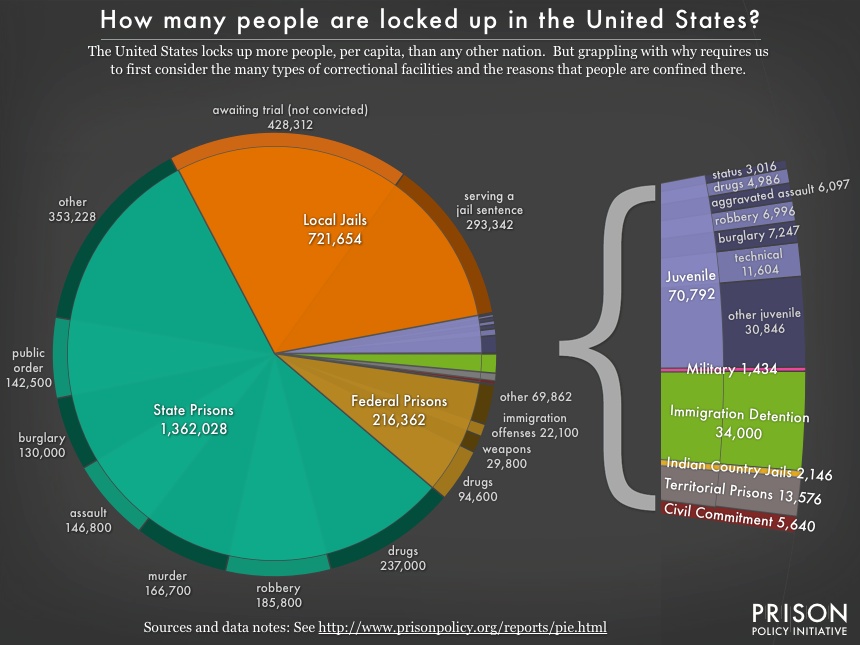 One out of every three people who are locked up tonight are sitting in a local jail, not a state or federal prison. There are 3,283 jails in America, yet jails receive scant attention. The legislative, judicial and executive decisions that have fueled the explosion of our state prison populations are becoming well-known; but the myriad of subtle policy decisions that have sent our jail populations upwards are off the public’s radar.
One out of every three people who are locked up tonight are sitting in a local jail, not a state or federal prison. There are 3,283 jails in America, yet jails receive scant attention. The legislative, judicial and executive decisions that have fueled the explosion of our state prison populations are becoming well-known; but the myriad of subtle policy decisions that have sent our jail populations upwards are off the public’s radar.
Jails need to be a policy focus, as the Vera Institute of Justice recently argued in its aptly-titled report Incarceration’s Front Door: The Misuse of Jails in America.
Jails matter because a staggering 11 million people cycle through them each year. As we explained last year:
Jail churn is particularly high because at any given moment most of the 722,000 people in local jails have not been convicted and are in jail because they are either too poor to make bail and are being held before trial, or because they’ve just been arrested and will make bail in the next few hours or days. The remainder of the people in jail — almost 300,000 — are serving time for minor offenses, generally misdemeanors with sentences under a year.
So when we talk about jails we have to keep our eye on two numbers: the number of people in jail on a given day and the sheer volume of people who cycle through them as shown in this analysis of Bureau of Justice Statistics data:
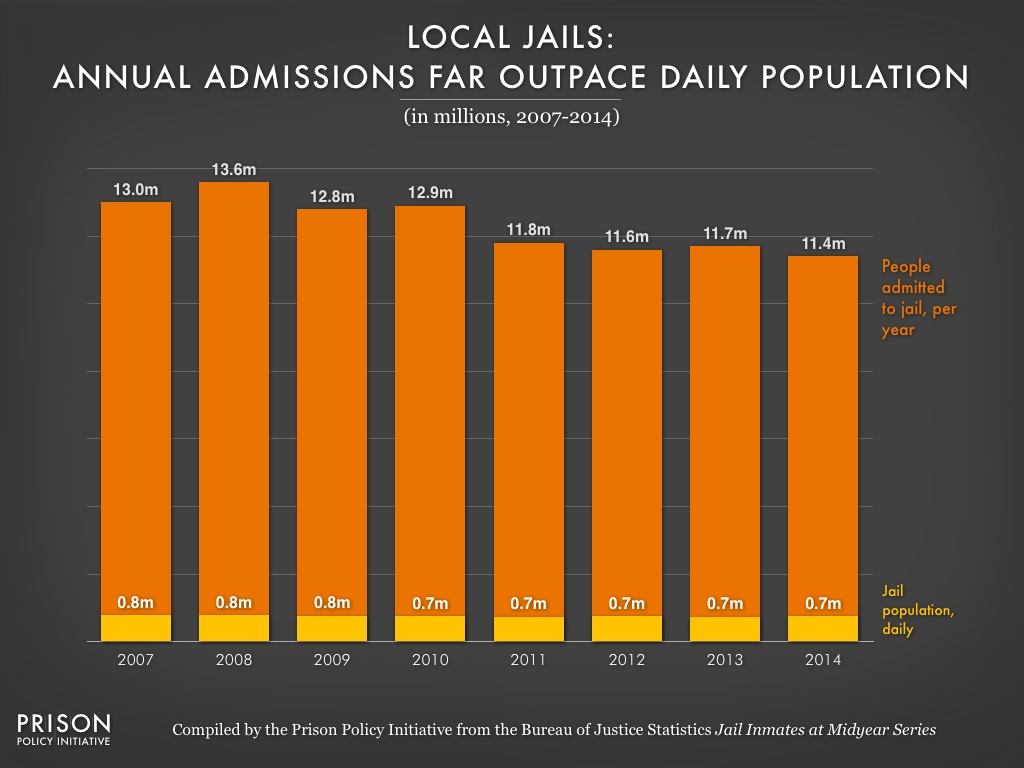 Addressing the problem of jails means grappling with the tremendous churn through jails. How can we lessen the numbers who enter jails and reduce the time that 11 million people spend there each year?
Addressing the problem of jails means grappling with the tremendous churn through jails. How can we lessen the numbers who enter jails and reduce the time that 11 million people spend there each year?
This “pre-trial” or “unconvicted” population is driving the growth in jail populations. In fact, 99% of the growth in jails over the last 15 years has been a result of increases in the pre-trial population:
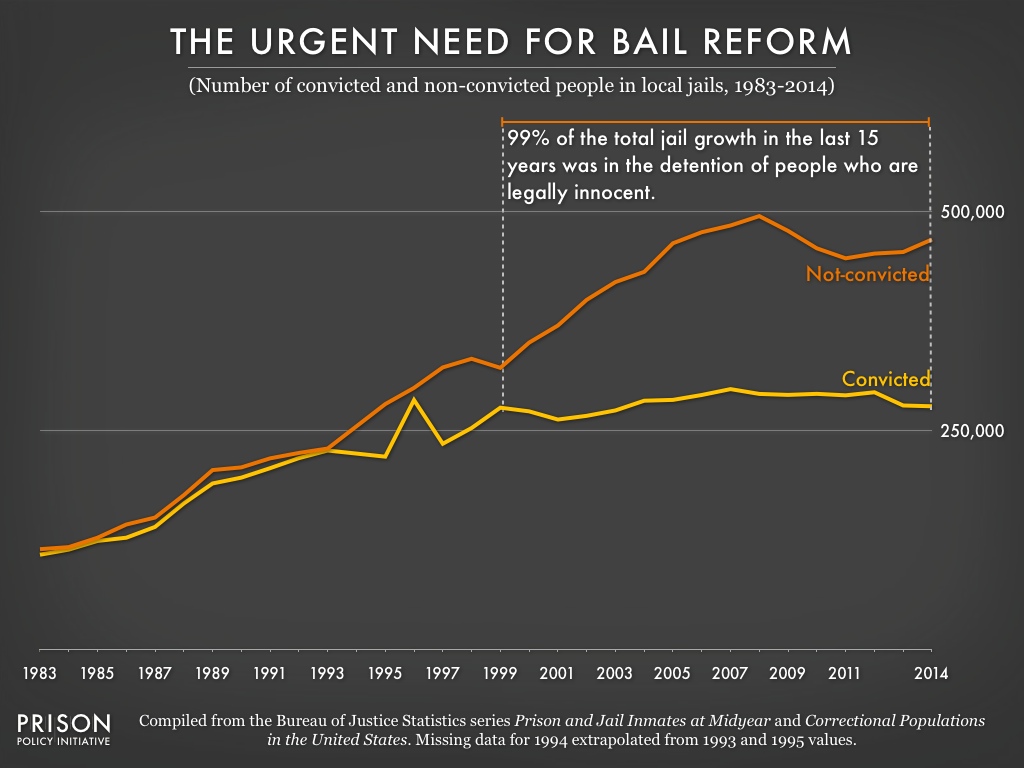 Virtually all of the growth in the jail population has been in the number of legally innocent people who are detained in jails.
Virtually all of the growth in the jail population has been in the number of legally innocent people who are detained in jails.
These people are legally considered innocent until proven otherwise in court. But if they don’t have the money to post bail, the principle that they are legally innocent is not enough to keep them from being locked up until trial. A recent New York Times feature found that poverty is a frequent cause of pre-trial detention: in New York City even when bail is set at $500 or less, 85% of defendants were unable to afford bail.
Besides the injustice of our jails resembling modern day debtor’s prisons, excessive bail can have other harmful effects. Family life is disrupted, jobs and housing can be lost, and the combined effects can literally be fatal. Pre-trial detention also coerces people to plead guilty to minor offenses, including people who are factually innocent like the man featured in the New York Times article. Studies have also shown that people who are detained pretrial are more likely to be convicted than those who are able to afford bail.
Fortunately, the movement for bail reform is growing in places like New York City and the state of Massachusetts. But at the same time as we work to fix bail, we really should admit that the problem starts even before a bail hearing.
As Peter Goldberg, executive director of the Brooklyn Community Bail Fund put it in the New York Times article:
And the truth is, even meaningful bail reform is just the beginning. The real work is asking why we’re arresting so many people on low-level offenses in the first place, and why so many of them come from poor black and brown communities. Bail is easy.
Or to be more precise: fixing bail should be easy. Why it’s taking so long is a good question and getting to the bottom of this country’s jail problem is going to depend on both reducing the number of people we send to jail each year and making it far easier for those who have been arrested to resume their lives while the judicial process proceeds.
 A couple of weeks ago, we wrote about the Bureau of Prisons’ newly proposed rule, which attempts to circumvent financial privacy protections for people who send money to their incarcerated loved ones.
A couple of weeks ago, we wrote about the Bureau of Prisons’ newly proposed rule, which attempts to circumvent financial privacy protections for people who send money to their incarcerated loved ones.








 Addressing the problem of jails means grappling with the tremendous churn through jails. How can we lessen the numbers who enter jails and reduce the time that 11 million people spend there each year?
Addressing the problem of jails means grappling with the tremendous churn through jails. How can we lessen the numbers who enter jails and reduce the time that 11 million people spend there each year? Virtually all of the growth in the jail population has been in the number of legally innocent people who are detained in jails.
Virtually all of the growth in the jail population has been in the number of legally innocent people who are detained in jails. 


